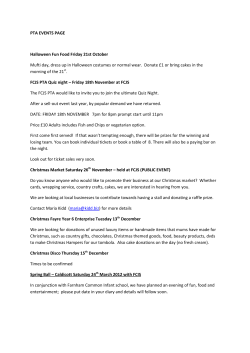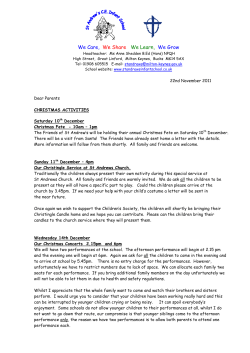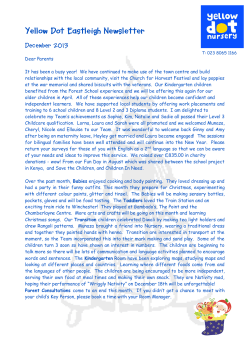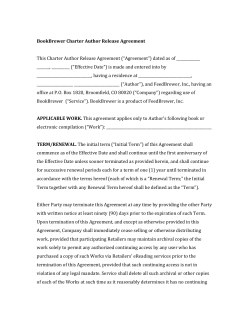
HOLIDAY Sheet Music for Children: Piano, guitar and more…
HOLIDAY Sheet Music for Children: Piano, guitar and more… To begin stimulating an interest in music in your child at this most wonderful time of the year! DISCLAIMER: This information is provided "as is”. Most sheet music from www.pitt/edu~deben; Gilbert DeBenedetti and NoelNoelNoel.Com, visit these sites for more music sheets ; intended for in home use only. eBook brought to you by: http://www.baby-can-read.com 1 CONTENTS -- INTRODUCTION -- CHAPTER 1- WHY TO STUDY MUSIC? THE IMPORTANT ROLE OF THE FAMILY! -- CHAPTER 2 – FIRST PIECES (CHRISTMAS MUSIC) -- CHAPTER 3 – MUSIC FOR THE GUITAR AND/OR LYRICS FOR CAROLING -- CHAPTER 4 – OTHER MUSIC FOR CELEBRATING THE HOLIDAYS eBook brought to you by: http://www.baby-can-read.com 2 INTRODUCTION Here we present an Ebook with quick and easy ways to stimulate Music Appreciation in your own family this Christmas season - sheet music. The best part is, it's absolutely free! So, if your child is beginning to play their music instrument, or is more experienced, you can still add this to your repertoire come Christmas Eve. Here are some free Christmas sheet music for you to enjoy and a new article on fostering Music Appreciation in your family. eBook brought to you by: http://www.baby-can-read.com 3 CHAPTER 1- WHY TO STUDY MUSIC? THE IMPORTANT ROLE OF THE FAMILY! The 21st century will see children be born that are capable to build such complex thoughts that these will be the reflection of new ways to explain and understand a world that will be becoming more difficult for us to define. We have to educate them well for the survival of our species, for an increased sensitivity towards other human beings, for increasing comprehension of diversity and for maintaining peace in our planet. All our efforts towards defending what belongs to us, our nations, and the Earth will be wasted unless we consider that mankind needs peace, internally and externally. What good does us to prepare our children other than for the evolution of our species, the advancement of arts and science, the increased understanding of the roles of different cultures, the search for spiritualism? Why prepare our children for other than developing the need for them to become better each day that passes? Philosophy, antropology, sociology, psychology, among other disciplines, highlight themes of importance, among them those that explain the importance of deriving meaning and increasing communication in interactions among men. Each one of our generations sees itself creating meaning for what was defined regarding the importance of life in society, and as the time passes, the new inhabitants of Earth create new ways in which to explain new meanings to facts and acts in which men find themselves involved in. Men need to comprehend each other. One culture needs to value the others. The teaching of music can provide a favorable environment for a specific type of communication in society and this is why it is necessary to teach music to babies and infants. The earlier we start, the better! Teaching music provides the learning of signs and/or symbols, which amplify the human capacity to know and create from systems and conventions that the child cannot find in other systems and/or disciplines. And this practice helps develop intelligence. In this opportunity, other concepts are developed. Objects and processes which are unconventional are developed and from this arises the opportunigty for the musical cognitive system to satisfy a specific type of human desire: that of creating with sound, utilizing and thinking with sounds. Communicating with sound! To live musically gives the child the opportunity to develop meanings which go beyond those simply intellectual. Hence, the child exercises complex thoughts through experiencing music, by participating and integrating him/herself in this ‘difficult to define’ world. When the child is capable to communicate emotional needs, he/she exteriorizes esthetic meanings, treating the abstract in a concrete way and assigning objective meaning to other types of communication that he/she can create. Practicing music in groups unifies chidren. To listen to music created by another exercises communication abilities. To have your own music heard by others improves self-esteem. Music is not, however, a language. It results from complex systems of sound utilization, which through form, structure, and the instruments it utilizes, concretizes itself through eBook brought to you by: http://www.baby-can-read.com 4 the works, and conveys meaning. This is why music has to be taught to be understood in all its complexity. The result for someone listening, or making music, is the exchange of emotions. And the exchange of emotions promotes simplicity in this interaction. This exchange also deepens communication. These manipulations with sound and structural models must be linked to the context in which the individuals involved in the musical experience are into. Therefore, each musical experience communicates the disposition, creativity, and traces of different cultures, which reflect themselves in the processes of musical production, appreciation, and reproduction. In this manner, in order for us to defend the idea that it is necessary to promote internal and external peace for mankind, we need to foment learning and musical experience for our children, since an early age. Music is life. It involves us since it is a human creation. It can be created and executed by us throughout many phases of our development. It is in the satisfaction of making music that children involve themselves cognitively with processes of creativity, problem-solving, and gaining the initiative to take risks, to express themselves, and to evolve as a thinker and innovator. Musical learning leads to interpersonal relationships, acceptance by the group, the desire to create, and the motivation to communicate. In the following paragraphs we will suggest some ideas about how to promote teaching/learning music in our families: 1 – How to lead the musical experience? First, babies or young children need a favorable environment. It is necessary to create success values in the family. In order to have success it is necessary that the parents have courage and take risks to live happy days and each day more satisfying moments for their children. We can enumerate 10 aspects that must be considered if we would like to improve our success in creating a more musical environment for our children: 1 – SUCCESS! Believe that your child is capable to understand and to make music! In the least this will create a person with music appreciation and will be part of an audience that will understand and will derive satisfaction from quality music. S/he will capable to appreciate our collective and historical musical culture of mankind and will be able to maintain it and promote it. 2 – OPTIMISM! Yes, it is possible to appreciate, create, live, and become highly satisfied with the musical activity and learning! Many are those who did and still currently do this. 3 – INITIATIVE! Have in mind an action plan. See how the child is going to be exposed or become into contact with music. Will it be through and/or from listening since eBook brought to you by: http://www.baby-can-read.com 5 in utero? What kind of music will s/he listen to? Only after birth will you expose the baby to music? Who might sing to the baby (nursery rhymes or other songs)? Have you selected them? Have you found out whether music from a particular musical instrument pleases the baby more? One must remember that any and all initiative must lead to experiencing music daily, and always in an environment of satisfaction and appreciation for music of good quality. 4 – GOALS! It is necessary to know where the family wants to arrive. It is necessary to ask whether experiencing music leads to increasing music appreciation in the family, community and county, or whether it is to develop musical performers/musicians. You should establish goals and follow the development of music cognitive skills and then this will lead to a decision of whether or not the child should dedicate him/herself to professional performance. If the child decides, between 6 and 10 years of age, that s/he wants to deepen his/her knowledge as a performer, new goals will have to be developed and implemented. We have to embrace the idea together with the child if this makes them happy and indeed encourage them to play and pursue the mastery of their favorite instrument. 5 – WORK! Work means regularity, seriously dedicating yourself to the compromise of providing the child with the opportunity to experience music everyday. Work means to develop, through music, habits and attitudes of musical execution. This means that there has to be dedication to learning music theory, vocal, instrumental, and improvisational practices. And that there must be a commitment to theoretical learning (musical concepts) and musical elements essential to the utilization of musical structures and schemes in the process of musical experiencing and creation . 6- COMMUNICATION! Music is an excellent medium for teaching us the importance of communication. A baby’s cry already is an element of communication and it is composed by notes and musical intervals. Many children sing, hum melodies long before they begin to speak. Therefore, when music is already being exercised and played, musical improvisation becomes an example of sophistication reached by those executing the process. It is possible that different culture see themselves through similarities of esthetic emotions promoted by listening to different songs, which bring in their scope similar musical ideas. It is possible for people from one culture to love and admire another due to their music. Music creates communication links and bridges the distance among men. 7- ATTITUDES! It is necessary to believe in the importance of teaching music in order for children to develop in a rich and healthy way. The alignment of the parents’ attitudes to that of valueing music, is understood and assimilated by the children. Parents that dislike classical or popular music, or any other type of music, pass this attitude down to their children. What matters is to help our children by giving them the opportunity to evolve, become better than ourselves, for the benefit of all of humanity. In this context, attitude means to pass down to your children the family values of musical appreciation. eBook brought to you by: http://www.baby-can-read.com 6 8- PERSISTENCE! Musical learning only becomes reality when the child has a desire/disposition to make music. In order for us to find our whether s/he has this disposition, s/he has to be exposed and has to experience music. Hence, it is necessary to give time and continuity to the exposure to music so that the cognitive development system can go through the appropriate stages. In order to develop cognitively in a musical context, it is necessary for the parents and children to remain persistent, which will result in the succession of levels which lead to each day deeper knowledge and complex specialized learning. 9- PRACTICING! All the steps above lead to a system of how to experience music. The child that experiences rewarding musical practice goes on to practice music, in a routine of instrumental study which will lead s/he to aesthetic expression through execution of his/her works or works of other composers. 10- CONCLUSION: The child’s process of experiencing music, with parental support, will lead to a unique reality: A dream has been visualized, goals have been set, and the participants have been persistent. There has been practicing of communication, training to reach the goals outlines, and a conclusion about what should be done at each step lived. To “live” and experience music and learning “how to make music” adds much to family life and this increment in quality provides improved communication in society. The overall result is a quest for the evolution of humanity, through the cultivation of art, intelligence, and emotion. eBook brought to you by: http://www.baby-can-read.com 7 CHAPTER 2- FIRST PIECES FOR YOUNGER CHILDREN (Piano or Guitar) eBook brought to you by: http://www.baby-can-read.com 8 eBook brought to you by: http://www.baby-can-read.com 9 eBook brought to you by: http://www.baby-can-read.com 10 eBook brought to you by: http://www.baby-can-read.com 11 eBook brought to you by: http://www.baby-can-read.com 12 eBook brought to you by: http://www.baby-can-read.com 13 eBook brought to you by: http://www.baby-can-read.com 14 eBook brought to you by: http://www.baby-can-read.com 15 eBook brought to you by: http://www.baby-can-read.com 16 eBook brought to you by: http://www.baby-can-read.com 17 eBook brought to you by: http://www.baby-can-read.com 18 eBook brought to you by: http://www.baby-can-read.com 19 CHAPTER 3- MUSIC FOR GUITAR: FROSTY THE SNOW MAN S.Nelson, J.Rollins(c) 1950 [suggest Capo V] C Frosty the Snow Man F C was a jolly happy soul F C With a corn-cob pipe and a button nose F G7 and two eyes made out of coal. C Frosty the Snow Man F C is a fairy tale they say F C Am He was made of snow but the children know F G7 C how he came to life one day. F Em There must have been some magic in Dm G7 C that old silk hat they found, G E For when they put it on his head D7 G7 he began to dance around. C Oh, Frosty the Snow Man F C was alive as he could be, F C Am And the children say he could laugh and play F G C just the same as you and me. Frosty the Snow Man knew the sun was hot that day, So he said, "Let's run and we'll have some fun now before I melt away." Down to the village with a broomstick in his hand, Running here and there all around the square, saying "Catch me if you can." He led them down the streets of town right to the traffic cop, And he only paused a moment when he heard him holler, "Stop!" Frosty the Snow Man had to hurry on his way, But he waved good-bye, saying, "Don't you cry; I'll be back again some day." eBook brought to you by: http://www.baby-can-read.com 20 C Thumpety thump thump, thumpety thump thump, G7 Look at Frosty go. Thumpety thump thump, thumpety thump thump, C Over the hills of snow. CHORDS USED: G7 eBook brought to you by: http://www.baby-can-read.com 21 THE CHRISTMAS SONG (as performed by Nat King Cole) Db6 Ebm7 Fm7 Gbmaj7 (Fm7 Ebm7) Chestnuts roasting on an open fire Db6 Abm7 Db7 Gbmaj7 B9 Jack Frost nipping at your nose Db6 B9 Bbm7 Gm7 Gb7 Yuletide carols being sung by a choir Fmaj7 F#m7 B9 Emaj7 Ebm7 D9 And folks dressed up like Eskimos.......everybody Db6 Ebm7 Fm7 Gbmaj7 (Fm7 Ebm7) knows a turkey and some mistletoe Db6 Abm7 Db7 Gbmaj7 B9 Help to make the season bright Db6 B9 Bbm7 Gm7 Gb7 Tiny tots with their eyes all aglow Fm7 E9 Ebm7 D9 Db6 Will find it hard to sleep tonight Abm7 Db7 Gbmaj7 They know that Santa's on his way Abm7 Db7 Gbmaj7 He's loaded lots of toys and goodies on his sleigh F#m7 B7 Emaj7 And every mother's child is gonna spy Eb7 Ab7 To see if reindeer really know how to fly Db6 Ebm7 Fm7 Gbmaj7 (Fm7 Ebm7) And so I'm offering this simple phrase Db6 Abm7 Db7 Gbmaj7 B9 To kids from one to ninety-two Db6 B9 Bbm7 Gm7 Gb7 Although it's been said many times, many ways Fm7 E9 Ebm7 Ab7 Db6 Merry Christmas to you CHORDS USED: Db6 (x4332x) Ebm7 (x68676) Fm7 (x810898) Gbmaj7(x91110119) Abm7 (464444) Db7 (x46464) Gbmaj7(2x332x) B9 (x2122x) eBook brought to you by: http://www.baby-can-read.com 22 ANGELS WE HAVE HEARD ON HIGH (alternate to Angels from the Realms of Glory) open by playing a C chord. starting melody note is open 1st string repeat CHORUS after every verse. C G C Angels we have heard on high, C G C Singing sweetly through the night, C G C And the mountains in reply C G C Echoing their brave delight. CHORUS: C A7 Dm G C F G Gloria............... C G C F G in excelsis Deo. C A7 Dm G C F G Gloria............... C G C F G C in excelsis Deo. C G C Shepherds, why this jubilee? C G C Why these songs of happy cheer? C G C What great brightness did you see? C G C What glad tiding did you hear? ADDITIONAL VERSES: Come to Bethlehem and see Him whose birth the angels sing; Come, adore on bended knee Christ, the Lord, the new-born King. See him in a manger laid Whom the angels praise above; Mary, Joseph, lend your aid, While we raise our hearts in love. CHORDS USED: C (x32010) G (320003) F (xx3211) A7 (x02020) Dm (xx0231) eBook brought to you by: http://www.baby-can-read.com 23 IT'S THE MOST WONDERFUL TIME OF THE YEAR Waltz time D Bm Em A D Bm Em A It's the most wonderful time of the year Em A D With the kids jingle belling and everyone telling you G G#dim7 "Be of good cheer" D Bm Em A D Em A It's the most wonderful time of the year. D Bm Em A D Bm Em A It's the hap - happiest season of all Em A D With those holiday greetings and gay, happy meetings G G#dim7 When friends come to call, D Bm Em A D Am D it's the hap - happiest season of all. G G#dim7 D Bm There'll be parties for hosting, marshmallows for toasting, Em A D and caroling out in the snow. Gm C F Dm There'll be scary ghost stories and tales of the glories Em7b5 Bb Em A of Christmases long, long ago. D Bm Em A D Bm Em A It's the most wonderful time of the year. Em A D There'll be mistle-toeing, and hearts will be glowing G G#dim7 when loved ones are near. D Bm Em A D It's the most wonderful time of the year. UNUSUAL CHORDS: G#dim7 (4x343x) Em7b5 (0x2333) (low E is optional eBook brought to you by: http://www.baby-can-read.com 24 JOY TO THE WORLD Words adapted from Psalm 98 by Isaac Watts, 1719. Music by George F. Handel, 1742. Public Domain. C Dm C G C Joy to the world! The Lord is come; F G C Let earth receive her King. C Let every heart prepare Him room, C And heav'n and nature sing, G And heav'n and nature sing, C F C Dm C G7 C And heav'n and heav'n and nature sing. Additional Verses: Joy to the world! The Savior reigns; Let men their songs employ. While fields and floods, rocks, hills and plains Repeat the sounding joy, Repeat the sounding joy, Repeat, repeat the sounding joy. No more let sins and sorrows grow, Nor thorns infest the ground; He comes to make His blessings flow Far as the curse is found, Far as the curse is found, Far as, far as the curse is found. He rules the world with truth and grace, And makes the nations prove The glories of His righteousness, And wonders of His love, And wonders of His love, And wonders, wonders of His love. eBook brought to you by: http://www.baby-can-read.com 25 LET IT SNOW! Sammy Cahn, J.Styne (c) 1945 F C7 F Oh, the weather outside is frightful, F Abdim C7 But the fire is so delightful, Gm D7 Gm And since we've no place to go, C7 F Let it snow, let it snow, let it snow. F C7 F It doesn't show signs of stopping, F Abdim C7 And I brought some corn for popping. Gm D7 Gm The lights are turned way down low, C7 F Let it snow, let it snow, let it snow. C When we finally kiss good night, Dm G7 C How I'll hate going out in the storm. C But if you really hold me tight, D7 G7 C7 All the way home I'll be warm. F C7 F The fire is slowly dying, F Abdim C7 And, my dear, we're still good-bye-ing, Gm D7 Gm But as long as you love me so. C7 F Let it snow, let it snow, let it snow. eBook brought to you by: http://www.baby-can-read.com 26 RUDOLPH THE RED NOSED REINDEER C Rudolph the red-nosed reindeer, G7 Had a very shiny nose, And if you ever saw it, C You would even say it glows. C All of the other reindeer, G7 Used to laugh and call him names, They never let poor Rudolph, C C7 Join in any reindeer games. F C Dm G7 C Then one foggy Christmas Eve, Santa came to say, G D7 G7 "Rudolph with your nose so bright, won't you guide my sleigh tonight?" C Then how the reindeer loved him, G7 As they shouted out with glee, "Rudolph the red-nosed reindeer, C You'll go down in history." eBook brought to you by: http://www.baby-can-read.com 27 THE TWELVE DAYS OF CHRISTMAS On the <D>first day of Christmas my <A>true love gave to <D>me, A <D>part<G>ridge <D>in a <A>pear <D>tree. On the <D>second day of Christmas my <A>true love gave to <D>me, <D>Two turtle doves, And a <D>part<G>ridge <D>in a <A>pear <D>tree. On the <D>third day of Christmas my <A>true love gave to <D>me, <D>Three French hens, two turtle doves, And a <D>part<G>ridge <D>in a <A>pear <D>tree. On the <D>fourth day of Christmas my <A>true love gave to <D>me, <D>Four calling birds, three French hens, two turtle doves, And a <D>part<G>ridge <D>in a <A>pear <D>tree. On the <D>fifth day of Christmas my <A>true love gave to <D>me, <D>Five <E>golden <A-tacet>rings. <D>Four calling birds, three French hens, two turtle doves, And a <D>part<G>ridge <D>in a <A>pear <D>tree. On the <D>sixth day of Christmas my <A>true love gave to <D>me, <D>Six geese-a-laying, <D>Five <E>golden <A-tacet>rings. Four calling <D>birds, three <G>French hens, <A>two turtle <D>doves, And a <D>part<G>ridge <D>in a <A>pear <D>tree. eBook brought to you by: http://www.baby-can-read.com 28 On the <D>seventh day of Christmas my <A>true love gave to <D>me, <D>Seven swans-a-swimming, six geese-a-laying, <D>Five <E>golden <A-tacet>rings. Four calling <D>birds, three <G>French hens, <A>two turtle <D>doves, And a <D>part<G>ridge <D>in a <A>pear <D>tree. On the <D>eighth day of Christmas my <A>true love gave to <D>me, <D>Eight maids-a-milking, seven swans-a-swimming, six geese-a-laying, <D>Five <E>golden <A-tacet>rings. Four calling <D>birds, three <G>French hens, <A>two turtle <D>doves, And a <D>part<G>ridge <D>in a <A>pear <D>tree. On the <D>ninth day of Christmas my <A>true love gave to <D>me, <D>Nine ladies dancing, eight maids-a-milking, seven swans-a-swimming, Six geese-a-laying, <D>Five <E>golden <A-tacet>rings. Four calling <D>birds, three <G>French hens, <A>two turtle <D>doves, And a <D>part<G>ridge <D>in a <A>pear <D>tree. On the <D>tenth day of Christmas my <A>true love gave to <D>me, <D>Ten lords-a-leaping, nine ladies dancing, eight maids-a-milking, Seven swans-a-swimming, six geese-a-laying, <D>Five <E>golden <A-tacet>rings. Four calling <D>birds, three <G>French hens, <A>two turtle <D>doves, And a <D>part<G>ridge <D>in a <A>pear <D>tree. On the e<D>leventh day of Christmas my <A>true love gave to <D>me, E<D>leven pipers piping, ten lords-a-leaping, nine ladies dancing, Eight maids-a-milking, seven swans-a-swimming, six geese-a-laying, <D>Five <E>golden <A-tacet>rings. eBook brought to you by: http://www.baby-can-read.com 29 Four calling <D>birds, three <G>French hens, <A>two turtle <D>doves, And a <D>part<G>ridge <D>in a <A>pear <D>tree. On the <D>twelvth day of Christmas my <A>true love gave to <D>me, <D>Twelve drummers drumming, eleven pipers piping, ten lords-a-leaping, Nine ladies dancing, eight maids-a-milking, seven swans-a-swimming, Six geese-a-laying, <D>Five <E>golden <A-tacet>rings. Four calling <D>birds, three <G>French hens, <A>two turtle <D>doves, And a <D>part<G>ridge <D>in a <A>pear <D>tree. eBook brought to you by: http://www.baby-can-read.com 30 WINTER WONDERLAND G G Sleigh bells ring, are you listenin' D D In the lane, snow is glistening D7 Am D C A beautiful sight, we're happy tonight A D G Walking in a Winter Wonderland Gone away is In his place He's singing Walking in a the blue bird is the new bird our song, as we go along Winter Wonderland B F# B In the meadow we can build a snowman B F# B Then pretend that he is Parson Brown D A D He'll say "Are you married ?", We'll say "No man, D A D But you can do the job when you're in town." Later on, we'll conspire As we dream by the fire To face unafraid, the plans that we made Walking in a Winter Wonderland [Interlude over verse chords] B F# B In the meadow we can build a snowman B F# B And pretend that he's a circus clown D A D We'll have lots of fun with Mr.Snowman D A D Until the other kiddies knock him down When it snows, ain't it thrillin' Though you know, kids are chillin' We'll frolick & play, the Eskimo way Walking in a Winter Wonderland (wo oh oh ...) [repeat last line to fade] eBook brought to you by: http://www.baby-can-read.com 31 SANTA CLAUS IS COMING TO TOWN (Coots / Gillespie) G C You'd better watch out, you'd better not cry G C You'd better not pout, I'm telling you why G D7 G D7 Santa Claus is coming to town G C He's making a list, he's checkin' it twice G C He's gonna find out who's naughty and nice G D7 G Santa Claus is coming to town G7 C He sees you when you're sleeping G7 C He knows if you're awake A7 D He knows if you've been bad or good A7 D So be good for goodness sake G C You'd better watch out, you'd better not cry G C You'd better not pout, I'm telling you why G D7 G Santa Claus is coming to town OPTIONAL INTRO: G I just came back from a lovely trip Along the milky way A7 I call on dear old Santa Claus D7 To spend a holiday. eBook brought to you by: http://www.baby-can-read.com 32 SILENT NIGHT by Franz Gruber waltz 3/4 time C Silent night, holy night G C All is calm, All is bright F C Round yon Virgin, Mother and Child F C Holy Infant so Tender and mild, G C Sleep in heavenly peace, C G C Sleep in heavenly peace. Silent night, holy night Shepherds quake at the sight, Glories stream from heaven afar, Heavenly hosts sing Alleleulia Christ the Saviour is born! Christ the saviour is born. Silent night, holy night Son of God, love's pure light Radiant beams from Thy holy face with the dawn of redeeming grace, Jesus Lord at thy birth, Jesus Lord at thy birth. eBook brought to you by: http://www.baby-can-read.com 33 CHAPTER 4- OTHER MUSIC FOR CELEBRATING THE HOLIDAYS: eBook brought to you by: http://www.baby-can-read.com 34 eBook brought to you by: http://www.baby-can-read.com 35 eBook brought to you by: http://www.baby-can-read.com 36 MORE FREE SHEET MUSIC FOR ADDITIONAL INSTRUMENTS CAN BE FOUND AT: http://www.music-scores.com/Christmas_Carol_Melodies_for_many_instruments.pdf Hope you have enjoyed our compilation and Happy Holidays! Baby-can-read team eBook brought to you by: http://www.baby-can-read.com 37
© Copyright 2025





















